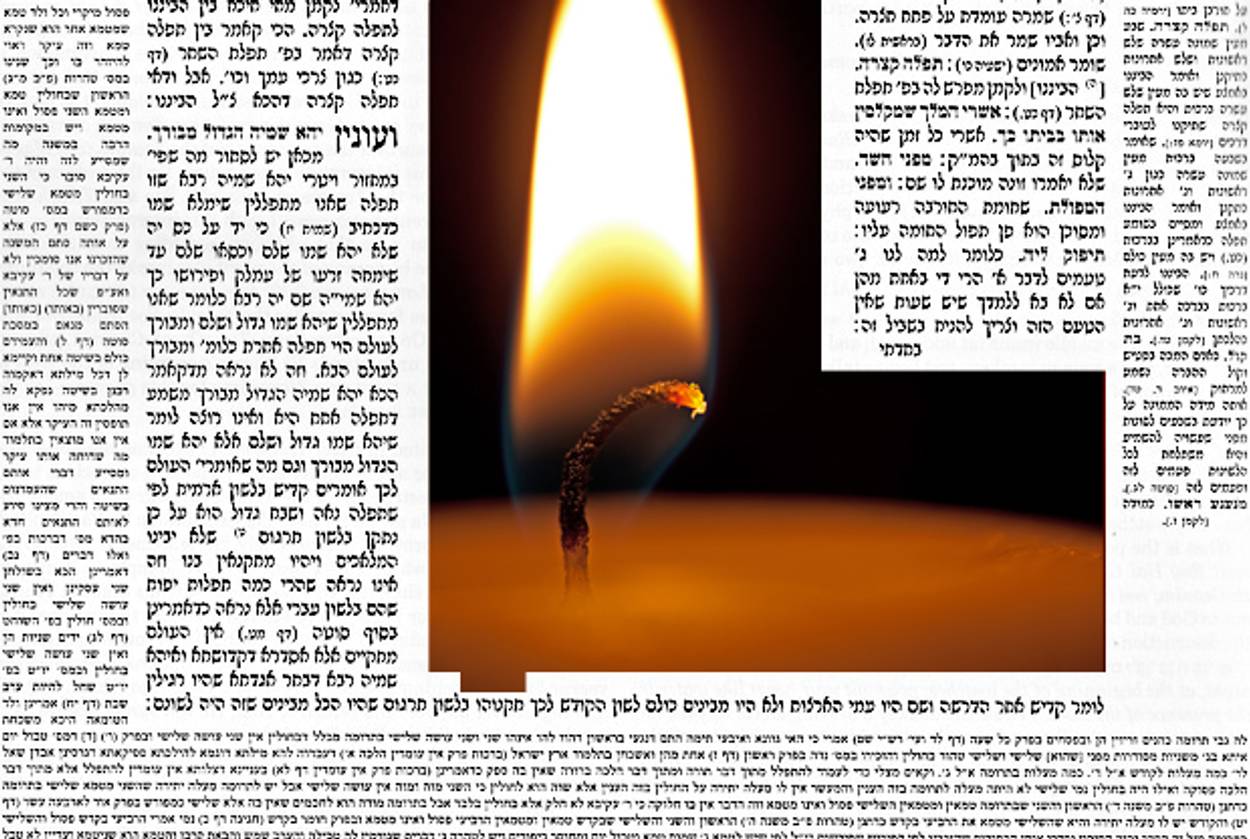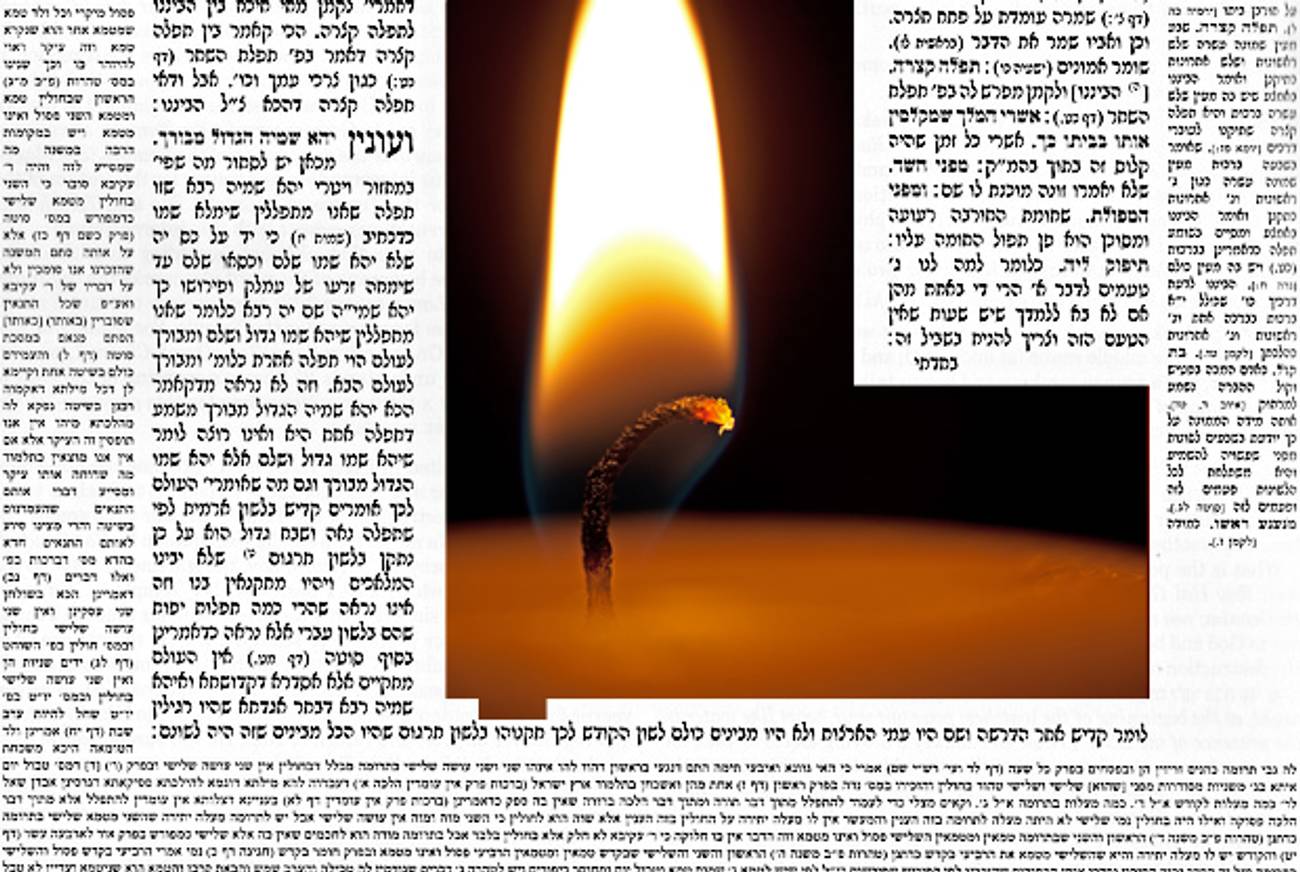Light Advice From the Rabbis
A Talmudic discussion of Hanukkah and Sabbath candles leads to a lesson in the sacred and profane




Literary critic Adam Kirsch is reading a page of Talmud a day, along with Jews around the world.
The next holiday coming up on the Jewish calendar is Hanukkah, and by a nice coincidence, the Festival of Lights was a major subject of this week’s Daf Yomi reading. That the Talmud ends up treating Hanukkah in a tractate devoted to the laws of the Sabbath is not too surprising: After several months of reading, I’ve gotten used to the counterintuitive ways the rabbis move from one topic to another, often by the subtlest of links. In this case, the connection comes early in Chapter 2 of Tractate Shabbat, when the Mishnah lists the kinds of substances that may not be used to kindle a Sabbath light: The wick can’t be made of “raw flax, silk fiber, weeds growing upon the water,” nor can the oil be “pitch, wax, cotton-seed oil, and … tallow.” These are disqualified not on biblical or ritual grounds, but on pragmatic ones, as Rabbah explained: “The wicks concerning which the Sages said we may not kindle with them on the Sabbath are unacceptable because the flame flickers on them. The oils … are unacceptable because they are not drawn easily into the wick.”
The segue to Hanukkah comes in Shabbat 21a, when Rav Huna declares that all the substances banned for Sabbath candles are also banned for Hanukkah candles. He gives two reasons for this: first, that it is required to keep the Hanukkah candles burning all day, and second, that it is permitted to use the Hanukkah lights to work by. Both these purposes would be thwarted by the use of the inferior, prohibited materials. Rav, however, held the opposite: He taught that it was not required to keep the Hanukkah candles burning all day and that it was not permitted to work by them, on the grounds that the lights should be clearly in honor of the Hanukkah miracle, and not for any quotidian purpose. Consequently, Rav did not believe that the Sabbath prohibitions applied to Hanukkah lights. And the Gemara holds that Rav’s interpretation is the correct one. Indeed, we even hear of an Amora, named Abaye, who was converted to Rav’s opinion late in life and declared, “If I had been worthy, I would have acquired Rav’s teaching earlier.”
From here, the rabbis pursue the laws of Hanukkah, specifically those relating to the kindling of the lights, for several pages. Today, the custom is to add a candle to the menorah on each night, so that we start with one light and end with eight (nine, counting the shammes). But in the Second Temple period, there was a disagreement on this practice between the House of Hillel and the House of Shammai—a kind of division we have seen several times already in the Talmud. Beit Shammai preferred to start the holiday by burning eight candles, and then take one away each night. The reason we don’t do this today, but follow Beit Hillel’s practice instead, is explained by a lovely axiom: “In sacred matters we elevate and do not lower.”
The rabbis go on to explain the origin of Hanukkah, telling the familiar story of the Hasmonean rebellion against Syrian-Greek rule and the miracle of the oil that burned for eight days. These events occurred in the 160s BCE, and the books that recount them are not part of the Hebrew Bible. This means that the holiday of Hanukkah is not a biblical but a rabbinic institution; and as we have seen before, rabbinic decrees are of lesser authority than biblical ones.
This leads the Talmud to note an anomaly in the Hanukkah blessings. We praise God “who commanded us to light Hanukkah lights”: “But where,” the Gemara demands, “did He command us?” In fact, it was not God but the rabbis who commanded us to do this. Still, the Talmud attempts to reconcile this fact with the words of the blessing. Rav Arya cites a verse from Deuteronomy: “You shall not deviate from the word that they will tell you.” In context, “they” are the priests and judges of ancient Israel; but the rabbis see themselves as the priests’ inheritors, and they read the line as commanding obedience to all rabbinical decrees.
By this logic, however, everything the rabbis ordain should be considered just as sacred as what the Bible decrees—as the Gemara goes on to point out. The argument is finally settled by the common-sense opinion of Abaye: The blessing on Hanukkah is not absolutely required, but it is instituted “so that people do not treat [the holiday] with disrespect.” It follows that biblical holidays still take precedence over rabbinic ones: If a poor man has to choose between buying Shabbat candles and Hanukkah candles, the Talmud says he should pick the former.
The Talmud goes on to give instructions about who can kindle the Hanukkah light. Women can, but “deaf-mutes, idiots, and children” cannot, since they wouldn’t understand the significance of their actions—and where it should be displayed—prominently in a window or doorway, so that passersby can see it. I found myself most intrigued, however, by one of the more technical moments in the Hanukkah discussion. This comes in Shabbat 21b, when the rabbis deduce that the Hanukkah light cannot be displayed more than 10 tefachim above the ground (a tefach is just over three inches long). Their chain of reasoning involves a citation from another tractate of the Mishnah, dealing with tort law:
If a spark flies out from under a blacksmith’s hammer and went and damaged another’s property, the blacksmith is liable. If a camel laden with flax was passing through the public domain and its flax protruded into a shop and was ignited by the shopkeeper’s light, and the burning flax then set a mansion ablaze, the camel’s owner is liable for all damage. If, however, the shopkeeper placed his light outside the shop, in a public domain, the shopkeeper is liable. Rabbi Yehudah says: In the case of a Hanukkah light, the shopkeeper is not liable.
That last sentence, Ravina deduced, teaches something about the proper height for placing the Hanukkah light: “For if it enters your mind that one may place it above 10 tefachim, let the damaged party say to the shopkeeper: ‘You should have placed your Hanukkah light above the height of the camel and its rider.’ ” If it were permissible to place your light high in the air, in other words, the camel-driver would be able to blame the shopkeeper for not doing this, thus removing the danger of a fire. Since the camel-driver cannot use this argument, it follows that the Hanukkah light cannot be placed high in the air; it must be within the zone that could reasonably be reached by a camel’s burden, which the rabbis decide is 10 tefachim.
There are, I feel, two ways of reacting to this kind of argument, not mutually exclusive. The first is to admire the reasoning and connection-making abilities of the rabbis. Here, Ravina plucks a rule from an entirely different part of the Mishnah and makes a logical, if unexpected, deduction about the subject at hand, the Hanukkah light. This kind of adaptability is what allows Talmudists to continue to judge new cases even today, 1,500 years after the Talmud was compiled. At the same time, it’s easy to feel impatient with Ravina’s argument. He seems to be proposing a hypothetical so far-fetched (involving a careless camel-driver carrying flax past a shop on Hanukkah) that it could never happen in real life; it is legalistic in the bad sense.
And, perhaps to our surprise, the Gemara itself shares this impatience. Instead of Ravina’s argument, it offers a much more commonsensical explanation for why we are not supposed to elevate the Hanukkah light: “Perhaps, if the shopkeeper is put to a great deal of trouble, he will eventually refrain from performing the commandment of the Hanukkah lights.” That is, it would be counterproductive to ask anyone to put their menorah 10 feet in the air, since the effort required to do so might make them stop lighting candles altogether. In this one sacred matter, at least, we lower and do not elevate.
***
Like this article? Sign up for our Daily Digest to get Tablet Magazine’s new content in your inbox each morning.
Adam Kirsch is a poet and literary critic, whose books include The People and the Books: 18 Classics of Jewish Literature.
Adam Kirsch is a poet and literary critic, whose books include The People and the Books: 18 Classics of Jewish Literature.